Subsection of Roman Times:
A weblog of links to and abstracts from academic presentations on the Roman Empire
Tuesday, December 30, 2003
Just Wars and the Roman Empire
"The earliest mention of distinction between 'just war' (bellum justum) and 'unjust war' (bellum injustum) can be traced back to the Roman Empire. As long as the Roman Emperors had not embraced Christianity, the Church upheld a pacifistic posture and even forbade Christians to enlist as soldiers. After Christianity had become the official religion of the Roman Empire in the days of Constantine, the Church was compelled to modify its view about war. From that point onwards, the Christians were required to shed their blood for the Empire. The Church had to find a moral ground for this change and this was done by Saint Augustine. He enunciated that every war was a lamentable phenomenon, but the wrong suffered at the hands of the enemy imposed 'the necessity of waging just wars'. This was later refined by Saint Thomas Aquinas."
Monday, December 29, 2003
Roman silver hoard to be featured exhibit in Basel, Switzerland
 "Pieces of treasure hidden by the Romans 1,650 years ago as Germanic tribes stormed their northern Swiss fort at Augusta Raurica, have been reunited and put on display for the first time.
"Pieces of treasure hidden by the Romans 1,650 years ago as Germanic tribes stormed their northern Swiss fort at Augusta Raurica, have been reunited and put on display for the first time.
Some 270 precious items including silver platters, dishes, utensils and coins, are on show amid tight security at the Museum of the Roman town of Augusta Raurica, in Basel."
"The objects date back to the tumultuous era between 294 and 350 AD. The name Marcellianus appears on 13 items. It is possible that he and an unnamed owner buried their belongings together and only Marcellianus labelled what was his."
"Both men were undoubtedly army officers. An inscription on one of the dishes shows Marcellianus to have been a tribune – a unit commander or staff officer. His candelabrum, made to be packed together like a telescope, hints at a life of frequent travel. "
"Marcellianus apparently served with the imperial court as the emperor moved about the Balkans and westwards to Gaul."
"One of his bowls is from Thessalonica and is a typical gift of the emperor to loyal followers. Another dish celebrates the tenth jubilee of the reign of Emperor Constantine. "
"The maker’s marks on the Achilles dish and the “Euticus” dish also indicate that they are gifts from the emperor."
Wednesday, December 17, 2003
The History of Roman Beast Hunts
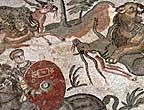 According to the 1875 Dictionary of Greek and Roman Antiquities by John Murray:
According to the 1875 Dictionary of Greek and Roman Antiquities by John Murray:
We do not know on what occasion a venatio was first exhibited at Rome; but the first mention we find of any thing of the kind is in the year B.C. 251, when L. Metellus exhibited in the Circus 142 elephants, which he had brought from Sicily after his victory over the Carthaginians, and which were killed in the Circus according to Verres, though other writers do not speak of their slaughter (Plin. H.N. viii.6). But this can scarcely be regarded as an instance of a venatio, since the elephants are said to have been only killed because the Romans did not know what to do with them, and not for the amusement of the people. There was, however, a venatio in the later sense of the word in B.C. 186, in the games celebrated by M. Fulvius in fulfilment of the vow which he had made in the Aetolian war; in these games lions and panthers were exhibited (Liv. xxxix.22). It is mentioned as a proof of the growing magnificence of the age that in the Ludi Circenses, exhibited by the curule aediles P. Cornelius Scipio Nasica and P. Lentulus B.C. 168, there were 63 African panthers and 40 bears and elephants (Liv. xliv.18). From about this time combats with wild beasts probably formed a regular part of the Ludi Circenses, and many of the curule aediles made great efforts to obtain rare and curious animals, and put in requisition the services of their friends (compare Caelius's letter to Cicero, ad Fam. viii.8). Elephants are said to have first fought in the Circus in the curule aedileship of Claudius Pulcher, B.C. 99, and twenty years afterwards, in the curule aedileship of the two Luculli, they fought against bulls (Plin. H.N. viii.7). A hundred lions were exhibited by Sulla in his praetorship, which were destroyed by javelin-men sent by king Bocchus for the purpose. This was the first time that lions were allowed to be loose in the Circus; they were previously always tied up (Senec. de Brev. Vit. 18). The games, however, in the curule aedileship of Scaurus B.C. 58 surpassed anything the Romans had ever seen; among other novelties he first exhibited an hippopotamos and five crocodiles in a temporary canal or trench (euripus, Plin. H.N. viii.40). At the venatio given by Pompey in his second consulship B.C. 55, upon the dedication of the temple of Venus Victrix, and at which Cicero was present (Cic. ad Fam. vii.1), there was an immense number of animals slaughtered, among which we find mention of 600 lions, and 18 or 20 elephants: the latter fought with Gaetulians, who hurled darts against them, and they attempted to break through the railings (clathri) by which they were separated from the spectators (Senec. l.c.; Plin. viii. 7.20). To guard against this danger Julius Caesar surrounded the arena of the amphitheatre with trenches (euripi).
In the games exhibited by J. Caesar in his third consulship, B.C. 45, the venatio lasted for five days and was conducted with extraordinary splendour. Camelopards or giraffes were then for the first time seen in Italy (Dion Cass. xliii.23; Suet. Jul. 39; Plin. H.N. viii.7; Appian, B. C. ii.102; Vell. Pat. ii.56
). Julius Caesar also introduced bull-fights, in which Thessalian horsemen pursued the bulls round the circus, and when the latter were tired out, seized them by the horns and killed them. This seems to have been a favourite spectacle; it was repeated by Claudius and Nero (Plin. H.N. viii.70; Suet. Claud. 21 ; Dion Cass. lxi.9). In the games celebrated by Augustus, B.C. 29, the hippopotamos and the rhinoceros were first exhibited, according to Dion Cassius (li.22), but the hippopotamos is spoken of by Pliny, as mentioned above, in the games given by Scaurus. Augustus also exhibited a snake 50 cubits in length (Suet. Aug. 43), and thirty-six crocodiles, which are seldom mentioned in spectacles of later times (Dion Cass. lv.10).
See: http://www.ukans.edu/history/index/europe/ancient_rome/E/Roman/Texts/secondary/SMIGRA%2A/Venatio.html
I also searched the web hoping to find a copy of Dr. Chris Epplett’s dissertation “The 'Creation' of the Roman Beast-Hunts” but I was unsuccessful. Here is an abstract:
The Roman beast-hunts (venationes), despite being popular arena spectacles, have generally received far less scholarly attention than the gladiatorial games with which they were associated. While numerous attempts have been made by modern scholars to explain the origin and purpose behind gladiatorial combat in the Roman empire, this and other aspects of the venationes have been relatively ignored by academics (Jennison's Animals for Show and Pleasure in Ancient Rome, written over 60 years ago, is a notable exception).
Antecedents for beast-hunts have been identified in Greek and Italic contexts, but the increasing violence of these events in the Late Republic can plausibly be linked to contemporary developments in gladiatorial combats. In my paper I investigate closely the process by which animal processions became animal slaughters. I do so first of all by noting that the violence of gladiatorial spectacles in Rome, which first became especially pronounced during the Second Punic War, was soon after followed by increasingly bloody animal spectacles in the course of the second century B.C. While this development may well have been linked to the increased supply of exotic animals which Roman conquests in this period made available, I will argue that a more important cause was competition between magistrates staging gladiator and animal spectacles; had the latter events remained mere processions of animals, they would have swiftly lost their appeal for Roman audiences otherwise becoming accustomed to public displays of bloodshed in the arena.
I checked the price of a copy of Animals for Show and Pleasure in Ancient Rome by George Jennison (1937) but it appears to be rather spendy to purchase it ($87 - $91). However, I found a copy in our research library.
Here is another website with a number of links to articles about Roman bloodsport:
http://duke.usask.ca/~porterj/CourseNotes/arena.html
Pain Management In The Dark ages
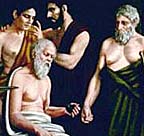 "The first medieval reference to anaesthesia was in the fourth century, in the writings of Hilary of Poitiers. Hilary was Bishop of Poitiers, exiled to the Orient in 356 A. D. by the Emperor Constantius. It was in the Orient that he first wrote about anaesthesia. He described drugs that lulled the soul to sleep. In 359 A. D Hilary returned to Poitiers. Apuleius, a compiler of medical literature in the fifth century wrote '...if anyone is to have a limb mutilated, burnt, or sawn, he may drink a half ounce with wine, and whilst he sleeps the member may be cut off without any pain or sense."
"The first medieval reference to anaesthesia was in the fourth century, in the writings of Hilary of Poitiers. Hilary was Bishop of Poitiers, exiled to the Orient in 356 A. D. by the Emperor Constantius. It was in the Orient that he first wrote about anaesthesia. He described drugs that lulled the soul to sleep. In 359 A. D Hilary returned to Poitiers. Apuleius, a compiler of medical literature in the fifth century wrote '...if anyone is to have a limb mutilated, burnt, or sawn, he may drink a half ounce with wine, and whilst he sleeps the member may be cut off without any pain or sense."
I also did not realize that hemlock was used in ancient times as an anesthetic (as well as a poison). However, this article pointed out the problems the ancients had with trying to regulate the dose and the sometimes dire consequences.
"Hemlock caused as many problems as it relieved. This is because the level of hemlock contained in leaves varied according to weather, climate, the age of harvesting of the plant, the conditions in which it was grown etc., and so the quantity of hemlock that was used in potions was not constant. This led to accidental overdoses and death."
Monday, December 15, 2003
Rediscovering Homer: Poetry and Performance
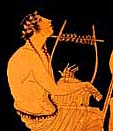 "Admired through the ages as the ultimate epic, Homer's Iliad, along with its companion-piece, the Odyssey, was venerated by the ancient Greeks themselves as the cornerstone of their civilization. By force of its prestige, the Iliad sets the standard for the definition of the word epic: an expansive poem of enormous scope, composed in an archaic and superbly elevated style of language, concerning the wondrous deeds of heroes."
"Admired through the ages as the ultimate epic, Homer's Iliad, along with its companion-piece, the Odyssey, was venerated by the ancient Greeks themselves as the cornerstone of their civilization. By force of its prestige, the Iliad sets the standard for the definition of the word epic: an expansive poem of enormous scope, composed in an archaic and superbly elevated style of language, concerning the wondrous deeds of heroes."
Thursday, December 11, 2003
Belisarius' Bid for Rome
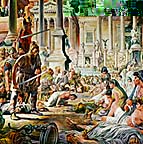 "On December 9, 536 AD, Byzantine Count Belisarius entered Rome through the Asinarian Gate at the head of 5,000 troops. At the same time, 4,000 Ostrogoths left the city through the Flaminian Gate and headed north to Ravenna, the capital of their Italian kingdom. For the first time since 476, when the Germanic king, Odoacer, had deposed the last Western Roman emperor and crowned himself 'King of the Romans,' the city of Rome was once more part of the Roman empire--albeit an empire whose capital had shifted east to Constantinople."
"On December 9, 536 AD, Byzantine Count Belisarius entered Rome through the Asinarian Gate at the head of 5,000 troops. At the same time, 4,000 Ostrogoths left the city through the Flaminian Gate and headed north to Ravenna, the capital of their Italian kingdom. For the first time since 476, when the Germanic king, Odoacer, had deposed the last Western Roman emperor and crowned himself 'King of the Romans,' the city of Rome was once more part of the Roman empire--albeit an empire whose capital had shifted east to Constantinople."
"Centuries of warfare against mounted enemies such as the Goths, Huns and Persians, however, had changed the makeup of the Roman army. By the 6th century ad, the army consisted primarily of a cavalry force of armored lancers, or cabalarii, wearing body armor and capable of handling a bow from horseback. Garrison duties and defensive positions were held by two types of infantry: lightly armed archers and heavily armed soldiers in mail jackets who fought with sword, ax and spear."
"For Belisarius' small army, the struggle for Rome required tactics that involved horsemen striking swiftly from walled cities much as the knights of a later age would do. The campaign would amount to a series of sieges against and sorties from fortified places rather than being fought in the field as early Roman wars had been."
"Nubia: The Forgotten Kingdom" Resists Rome
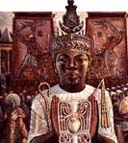 Last night I watched an interesting program on the Discovery Channel, “Nubia, The Forgotten Kingdom”, and learned that the Romans were defeated in battle by the Nubians led by a powerful Queen in 23 B.C. during the reign of Augustus. I was totally unfamiliar with this episode of Roman conflict. I did a little research and found this interesting reference:
Last night I watched an interesting program on the Discovery Channel, “Nubia, The Forgotten Kingdom”, and learned that the Romans were defeated in battle by the Nubians led by a powerful Queen in 23 B.C. during the reign of Augustus. I was totally unfamiliar with this episode of Roman conflict. I did a little research and found this interesting reference:
http://www.freemaninstitute.com/Gallery/nubia.htm
stating:
“Rome gained control of Egypt and all of the north African coastline and exacted tribute from Kush. Kush, called "Aethiopia" by the Romans (not to be confused with the present Ethiopia which was called Abyssinia by the Romans - see Axum), seeing Rome edge into lower Nubia, attacked and sacked the Roman outposts at Elephantine and Syene. the Romans retaliated and conquered the Kushite towns of Dakka and Premnis. Then Rome marched on Napata where the queen was in residence. She sued for peace and was refused. Rome then attacked Napata and razed it to the ground, making slaves of their captives. After that Rome fortified Premnis and kept it as their southernmost border while waging a three year war with Kush.”
”Finally, the Kandake marched upon Premnis and sued for peace, appealing to August Caesar. Impressed with the Kandake's appeal, and probably being aware that Rome had overextended itself at so distant a border, He accepted at about 20 BC. Kush was freed from further tribute, the borders were established at their Ptolemaic location, and Premnis was returned to Kushite control.”
I found more information at: http://www.internetpuppets.org/afrnubia.html
“Rome sent a legion, under the command of General Petronius (24 B.C. - 21 B.C.), to subdue Nubia and seize control of the gold trade. The Nubian army, led by Queen Amanirenas, smashed the Roman forces at Aswan, Philae, and Elephantine. The African army had stood against the most powerful state in the ancient world - Imperial Rome. This was Africa's finest hour. The Roman military had been stalemated and Nubia was divided into Lower Nubia (Roman) and Upper Nubia (Meroitic).”
”Meroitic history is filled with powerful Queen mothers. Women ruled with the same authority as men. The Meroitic alphabet has never been deciphered due to the lack of a translation key or Rosetta stone. The Nubians so disliked their Roman neighbors that a bust of Caesar Augustus was buried beneath a doorway to a temple.”
Strabo’s account of the action seems to downplay the Nubian’s successes:
Egypt was from the first disposed to peace, from having resources within itself, and because it was difficult of access to strangers. It was also protected on the north by a harborless coast and the Egyptian Sea; on the east and west by the desert mountains of Libya and Arabia, as I have said before. The remaining parts towards the south are occupied by Troglodytae, Blemmyae, Nubiae, and Megabarae Ethiopians above Syene. These are nomads, and not numerous nor warlike, but accounted so by the ancients, because frequently, like robbers, they attacked defenseless persons. Neither are the Ethiopians, who extend towards the south and Meroë, numerous nor collected in a body; for they inhabit a long, narrow, and winding tract of land on the riverside, such as we have before described; nor are they well prepared either for war or the pursuit of any other mode of life.
At present the whole country is in the same pacific state, proof of which is that the upper country is sufficiently guarded by three cohorts, and these not complete. Whenever the Ethiopians have ventured to attack them, it has been at the risk of danger to their own country. The rest of the forces in Egypt are neither very numerous, nor did the Romans ever once employ them collected into one army. For neither are the Egyptians themselves of a warlike disposition, nor the surrounding nations, although their numbers are very large.
Cornelius Gallus, the first governor of the country appointed by Augustus Caesar, attacked the city Hero?polis, which had revolted [in 28 B.C.], and took it with a small body of men. He suppressed also in a short time an insurrection in the Thebaïs which originated as to the payment of tribute. At a later period Petronius resisted, with the soldiers about his person, a mob of myriads of Alexandrines, who attacked him by throwing stones. He killed some, and compelled the rest to desist.
We have before related how Aelius Gallus, when he invaded Arabia with a part of the army stationed in Egypt, exhibited a proof of the unwarlike disposition of the people; and if Syllaeus had not betrayed him, he would have conquered the whole of Arabia Felix. The Ethiopians, emboldened in consequence of a part of the forces in Egypt being drawn off by Aelius Gallus, who engaged in war with the Arabs, invaded the Thebaïs and attacked the garrison, consisting of three cohorts, near Syene; surprised and took Syene, Elephantine, and Philae, a sudden inroad; enslaved the inhabitants, and threw down statues of Caesar. But Petronius, marching with less than 10,000 infantry and 800 horse against an army of 30,000 men, compelled them to retreat to Pselchis [former Maharraqa--now submerged beneath Lake Nasser], an Ethiopian city. He then sent deputies to demand restitution of what they had taken, and the reasons which had induced them to begin the war.
On their alleging that they had been ill-treated by the nomarchs, he answered, that these were not the sovereign of the country, but Caesar. When they desired three days for consideration, and did nothing which they were bound to do, Petronius attacked and compelled them to fight. They soon fled, being badly commanded, and badly armed; for they carried large shields made of raw hides, and hatchets for defensive weapons; some, however, had pikes, and others swords. Part of the insurgents were driven into the city, others fled into the uninhabited country; and such as ventured upon the passage of the river escaped to a neighboring island, where there were not many crocodiles on account of the current. Among the fugitives were the generals of the Candace, queen of the Ethiopians in our time, a masculine woman, and who had lost an eye. Petronius, pursuing them in rafts and ships, took them all and despatched them immediately to Alexandria. He then attacked Pselchis and took it. If we add the number of those who fell in battle to the number of prisoners, few only could have escaped.
From Pselchis Petronius went to Premnis [the former Karanog--now also submerged beneath Lake Nasser], a strong city, traveling over the hills of sand, beneath which the army of Cambyses [king of Persia, and successor to Cyrus the Great] was overwhelmed by the setting in of a whirlwind. He took the fortress at the first onset, and afterwards advanced to Napata. This was the royal seat of the Candace; and her son was there, but she herself was in a neighboring stronghold. When she sent ambassadors to treat of peace, and to offer the restitution of the prisoners brought from Syene, and the statues, Petronius attacked and took Napata, from which her son had fled, and then razed it. He made prisoners of the inhabitants, and returned back again with the booty, as he judged any farther advance into the country impracticable on account of the roads. He strengthened, however, the fortifications of Premnis, and having placed a garrison there, with two years' provisions for four hundred men, returned to Alexandria. Some of the prisoners were publicly sold as loot, and a thousand were sent to Caesar, who had lately returned from the Cantabrians, others died of various diseases.
In the meantime the Candace attacked the garrison with an army of many thousand men. Petronius came to its assistance, and entering the fortress before the approach of the enemy, secured the place by many expedients. The enemy sent ambassadors, but he ordered them to repair to Caesar: in their replying, that they did not know who Caesar was, nor where they were to find him, Petronius appointed persons to conduct them to his presence. They arrived at Samos, where Caesar was at that time, and from whence he was on the point of proceeding into Syria, having already despatched Tiberius into Armenia. The ambassadors obtained all that they desired, and Caesar even remitted the tribute which he had imposed. . .
Treasures of Tuscany New Exhibit Slated for Edinburgh
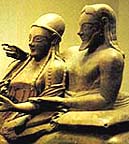 "A wealth of treasures collected from Etruscan tombs will go on display at the Royal Museum in Edinburgh beginning in July 2004. The three month exhibit will include fine ceramics, life-sized sarcophagi and objects from temples and sanctuaries such as architectural reliefs and bronze figurines.
"A wealth of treasures collected from Etruscan tombs will go on display at the Royal Museum in Edinburgh beginning in July 2004. The three month exhibit will include fine ceramics, life-sized sarcophagi and objects from temples and sanctuaries such as architectural reliefs and bronze figurines.
The Etruscans heavily influenced the Romans, and therefore modern-day Italy.
The origins of the Etruscan civilisation, which lasted for about 900 years, are not clear. In Italy, they developed what is believed to have been a refined culture and sophisticated agriculture, but their history was long shrouded in mystery because little was known about their language.
The Etruscans, who are credited with building Western Europe’s first cities, occupied lands in an area between present-day Florence and Rome, bordered by the Arno and Tiber rivers, in the regions known today as Umbria and Tuscany, as well as northern Lazio all the way to Rome. "
Monday, December 08, 2003
Size Does Matter - At Least During the Reign of Elagabalus
"The emperor Elagabalus appointed ministers in Rome through a competitive appraisal that Edward Gibbon, the 18th century historian of the Roman empire, described delicately as one based on 'enormitate membrorum.' "
According to Mad Monarchs:
"Originally Elagabalus was called Varius Avitus Bassianus. He became known as Elagabalus, because he was the high priest of the deity El-Gabal, possibly the Syrian sun god Baal. It was a phallic-oriented cult; the sun god was worshipped in the form of a great, black meteorite and two colossal phalli flanked the entrance of the temple in Emesa. When Elagabalus became Emperor, he attempted to introduce this Syrian cult to Rome. He had a new temple built on Rome's Palatine Hill and had El-Gabal's black relic transported to the new temple in a chariot decorated with gold and precious stones.
Elagabalus created a public bath inside the palace, so that he could collect paramours with remarkable phallic endowments. Even more infuriating to the people of Rome was the appointment of his lowborn lovers to the highest offices.
According to Mad Monarchs:
"Originally Elagabalus was called Varius Avitus Bassianus. He became known as Elagabalus, because he was the high priest of the deity El-Gabal, possibly the Syrian sun god Baal. It was a phallic-oriented cult; the sun god was worshipped in the form of a great, black meteorite and two colossal phalli flanked the entrance of the temple in Emesa. When Elagabalus became Emperor, he attempted to introduce this Syrian cult to Rome. He had a new temple built on Rome's Palatine Hill and had El-Gabal's black relic transported to the new temple in a chariot decorated with gold and precious stones.
Elagabalus created a public bath inside the palace, so that he could collect paramours with remarkable phallic endowments. Even more infuriating to the people of Rome was the appointment of his lowborn lovers to the highest offices.
Thursday, December 04, 2003
Imperatores Victi
By Nathan Rosenstein
"The glory and wealth that the city's conquerors gained by their victories paved the way to office, authority, and enhanced prestige when they returned to civilian life. But did that connection obtain in the other direction as well? Was military failure likely to bring serious political damage in its train? Athens in the fifth and fourth centuries seems to offer an obvious analogy. Then, too, successful war leaders enjoyed great influence in the political arena, but those whose operations failed regularly paid a heavy price. Thucydides is the best known but by no means the only politician to have had a career cut short by the domestic fallout from a military defeat. Prosecutions on charges brought by eisangelia were a constant danger to strategoi after battles were lost or when foreign-policy initiatives went awry. At Carthage the consequences could be even more frightening. The citizens there evinced a singular brutality when their armies met defeat: Punic commanders were crucified.
Common sense might suggest that punitive measures would have been equally prevalent at Rome. Military failure affected the citizens directly. The soldiers who filled the legions and suffered most when battles were lost voted in the assemblies, if they returned alive. And whether they did or not, their suffering touched relatives and friends, among whom the men also had votes. Even Romans with no personal ties to those in the ranks could be moved by anger and fear when defeat damaged the prestige of their city or imperiled its safety, and a hostile populace at Rome had effective ways of lashing out. The bulk of aristocratic competition took place under its arbitration, in elections for office or through the deliberations of judicial assemblies. Hatred and a desire for vengeance against the commander responsible therefore ought to have made themselves felt at the polls, ending his chances for further honors and perhaps even being visited on his descendants. Even greater danger could come from the courts. A military defeat might furnish grounds for a capital charge, and all such cases, until late in the history of the Republic, came before the voters in the comitiacenturiata for trial. To be effective, of course, public animosity needed leaders to marshal and focus it, but candidates would not have been lacking. Working up popular rage and exploiting it for political advantage or to humiliate a rival was commonplace among ambitious aristocrats. Men eager for office ought not to have let the electorate forget an opponent's earlier failures. Enemies should have been quick to bring a rival to trial when he had led Roman soldiers to defeat."
"The glory and wealth that the city's conquerors gained by their victories paved the way to office, authority, and enhanced prestige when they returned to civilian life. But did that connection obtain in the other direction as well? Was military failure likely to bring serious political damage in its train? Athens in the fifth and fourth centuries seems to offer an obvious analogy. Then, too, successful war leaders enjoyed great influence in the political arena, but those whose operations failed regularly paid a heavy price. Thucydides is the best known but by no means the only politician to have had a career cut short by the domestic fallout from a military defeat. Prosecutions on charges brought by eisangelia were a constant danger to strategoi after battles were lost or when foreign-policy initiatives went awry. At Carthage the consequences could be even more frightening. The citizens there evinced a singular brutality when their armies met defeat: Punic commanders were crucified.
Common sense might suggest that punitive measures would have been equally prevalent at Rome. Military failure affected the citizens directly. The soldiers who filled the legions and suffered most when battles were lost voted in the assemblies, if they returned alive. And whether they did or not, their suffering touched relatives and friends, among whom the men also had votes. Even Romans with no personal ties to those in the ranks could be moved by anger and fear when defeat damaged the prestige of their city or imperiled its safety, and a hostile populace at Rome had effective ways of lashing out. The bulk of aristocratic competition took place under its arbitration, in elections for office or through the deliberations of judicial assemblies. Hatred and a desire for vengeance against the commander responsible therefore ought to have made themselves felt at the polls, ending his chances for further honors and perhaps even being visited on his descendants. Even greater danger could come from the courts. A military defeat might furnish grounds for a capital charge, and all such cases, until late in the history of the Republic, came before the voters in the comitiacenturiata for trial. To be effective, of course, public animosity needed leaders to marshal and focus it, but candidates would not have been lacking. Working up popular rage and exploiting it for political advantage or to humiliate a rival was commonplace among ambitious aristocrats. Men eager for office ought not to have let the electorate forget an opponent's earlier failures. Enemies should have been quick to bring a rival to trial when he had led Roman soldiers to defeat."
Spectacle and Society in Livy’s History
"Livy's use of “spectacular” effects has traditionally been attributed to a desire to stimulate the emotions of his audience. Far from enhancing the credibility of his narrative, elaborate set pieces like the account of the fall of Alba Longa or of the scene in Rome following the announcement of Hannibal’s victory at Lake Trasimene, in which Livy combines an attention to the precise sensory components of the scene, such as the dust cloud rising over Alba, with a description of the extreme emotions of those actually present, have suggested that Livy’s was drawn away from his historiographical duties by “allure of dramatic techniques.”
"There is yet another dimension to enargeia’s capacity to make the past present. Within this passage, describing the profectio or ritual departure of the consul P. Licinius Crassus from Rome at the start of his campaign against Perseus of Macedon in 171 B.C.E., the process of vision plays a very precise role in communicating the social and political authority of the consul to the spectators and thus reinforcing the bond that links them to the collective power of the state:
It happened that during those days the consul P. Licinius, after offering vows on the Capitoline, set forth from the city in the costume of a general. This event is always [conducted] with great dignity and majesty, but it especially attracts eyes and minds when they follow a consul setting forth against a great enemy distinguished by his prowess or his fortune. For not only the performance of duty draws the crowd but also their enthusiasm for the spectacle, that they might see their leader, to whose power [imperium] and planning [consilium] they have entrusted the protection of the Republic itself. Then there enters their minds the reckoning of the contingencies of war, how uncertain is the outcome of fortune, and how impartial is Mars, what disasters have come about through the ignorance and rashness of the leaders, and yet what advantages have been the result of foresight and valor. What man knew which was the intellect and which the fortune of the consul they were sending to war? Would they soon see him in his triumph, ascending the Capitolium with his victorious troops to the same gods from whom he was setting out, or would they offer this pleasure to their enemies?
This digital version of Andrew Feldherr's work is part of the new eScholarship database of the University of California Press.
"There is yet another dimension to enargeia’s capacity to make the past present. Within this passage, describing the profectio or ritual departure of the consul P. Licinius Crassus from Rome at the start of his campaign against Perseus of Macedon in 171 B.C.E., the process of vision plays a very precise role in communicating the social and political authority of the consul to the spectators and thus reinforcing the bond that links them to the collective power of the state:
It happened that during those days the consul P. Licinius, after offering vows on the Capitoline, set forth from the city in the costume of a general. This event is always [conducted] with great dignity and majesty, but it especially attracts eyes and minds when they follow a consul setting forth against a great enemy distinguished by his prowess or his fortune. For not only the performance of duty draws the crowd but also their enthusiasm for the spectacle, that they might see their leader, to whose power [imperium] and planning [consilium] they have entrusted the protection of the Republic itself. Then there enters their minds the reckoning of the contingencies of war, how uncertain is the outcome of fortune, and how impartial is Mars, what disasters have come about through the ignorance and rashness of the leaders, and yet what advantages have been the result of foresight and valor. What man knew which was the intellect and which the fortune of the consul they were sending to war? Would they soon see him in his triumph, ascending the Capitolium with his victorious troops to the same gods from whom he was setting out, or would they offer this pleasure to their enemies?
This digital version of Andrew Feldherr's work is part of the new eScholarship database of the University of California Press.
Tuesday, December 02, 2003
Roman Law Resources
An excellent site on Roman Law created and maintained by Ernest Metzger, University of Aberdeen.
"This site provides information on Roman law sources and literature, the teaching of Roman law, and the persons who engage in the study of Roman law. "
"This site provides information on Roman law sources and literature, the teaching of Roman law, and the persons who engage in the study of Roman law. "
Subscribe to:
Comments (Atom)